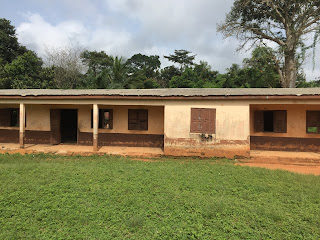"At a time that environmentalists and conservationists are developing narratives for advocacy campaigns to save these natural resources, the government of Ghana overtly puts additional log in the flaming pyre—the construction of the multi million-dollar Pokuase interchange which may deal the river the last blow".
"Tswa Omanye!", the Asafoatse exclaimed, as the ground swallowed the last pint of water
he released from the container. "Ehi eha wɔ", we
replied, to conclude the opening prayer before the meeting started. The pouring
of libation is not alien to Ghanaian tradition and so the call on the Supreme
Being to guide and influence the deliberations in the early morning was
expected.
My entire Monday evening the previous day was spent figuring
out the line of questions to pose to the high profile elder of Asere Clan I’d
be engaging the next morning. The Asafoatse
of the Pokuase area had arranged a meeting for Tuesday morning so I can
discuss the history behind the Gua Koo reserve and the Sunkwa River in Pokuase, as
part of my documentary on frontline communities, a collaborative project with
the Cambridge Climate Frontline Programme.
When the elder took the baton after the libation, my
questions, numbering up to 16 were rendered redundant. I tucked the sheets
beneath my note pad unnoticed, readied my pen and listened to him with rapturous
attention. The old man distilled the historical antecedents of the Ga people
with unrehearsed articulation. His flair for story telling in eloquent Ga
language kneaded with occasional stupendous English expressions is probably the
rubber stamp on his growing credentials as an authority on Ga history, and the
scribe for the Asere Clan. The latter has 45 towns and villages under it with
the headquarters as Ayawaso (original pronunciation: Ayi-Wa-So meaning ‘Ayi stopped on Thursday’).
The Gua Koo (Gua
Forest) from which Sunkwa flows dates
centuries ago. Gua is the name of a principal
god of the Ga people who followed them to Ayawaso from ancient Mizraim (present
day Egypt). Gua is a thunder and
lightning deity who is a fighter, protector and provider for the needy. According
to the elder, Gua was instrumental to the repair and sustenance of the people
after the Akwamus destroyed Ayawaso in the 17th Century. The forest provided food, water, shelter,
medicinal plants and fiber for clothing, that Ayawaso harnessed to crawl
back to health. That Gua is a provider and fighter even in modern day Pokuase
is a fact—residents testified in the course of my interviews that while nearby
water bodies will dry during drought, Sunkwa
will continue to flow to serve the
town and its surroundings.
 |
| The Gua forest reserve at Pokuase stretches from ACP junction eastwards from Achimota |
In the wake of massive
housing construction and pollution in the areas around the forest, the most
significant reason for the survival of the forest and the river is the annual traditional
rituals and religious rites performed in reverence and gratitude to Gua. Dispense
with the sacred and see the profaned and wanton decimation of Gua and Sunkwa
thriving dastardly in broad day Pokuase. At a time that environmentalists and
conservationists are developing narratives for advocacy campaigns to save these
natural resources, the government of Ghana overtly puts additional log in the
flaming pyre—the construction of the multi million-dollar Pokuase interchange
which may deal the river the last blow if the Environmental and Social Impact Assessment (ESIA) is not thoroughly scrutinized.
 |
| The Sunkwa has its source in the Gua Koo |
What is worth highlighting though is the fact that African
traditional ideas deserve a seat in the coliseum of national level
environmental engagements and global climate talks. While Western anthropocentric thought is the
root of the global environmental crisis, African primal tradition is a reservoir
of proven conservation ideas. Indeed, Al
Gore in his writings has called out astute Western thinker Francis Bacon
whose 16th Century philosophical views on human progress still influence
civilization’s stranglehold on the environment unalterably. Meanwhile, René Descartes’ definition of a particle when extrapolated within an ecological
framework ought to be further interrogated for consistency and environmental sustainability.
With the level of environmental degradation in Ghana and the dreadful
impacts of climate change which combined recently to intensify calls for water rationing in Ghana by the Ghana Water Company, it should be common sense for echelons
of government, civil society and private partners to plump for African
traditional conservation ideas to safeguard resources and national treasures
like Gua Koo and Sunkwa. With respect to these two, we are about to cross the
Rubicon.













